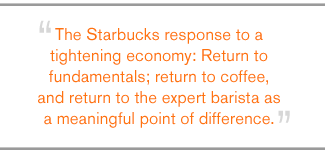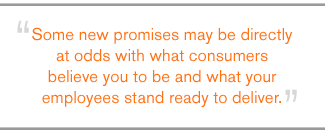A recent ���۴�ýPoll revealed that three in four Americans think the United States is in a recession. That may be at odds with the actual economic figures, since the country's GDP in fact increased slightly during the first quarter of the year.
 |
However, while there may be disagreement among economists, the nation's consumers appear united in their perceptions of today's economic conditions. Most Americans believe that a recession is already in full swing, and that belief tends to be reflected in their purchases and plans. (See "Most Americans Say U.S. Is Now in Economic Recession" and "Two Sliding Sectors Do Not a Recession Make" in the "See Also" area on this page.) This doesn't necessarily mean that they've stopped buying things, but they're definitely reconsidering their priorities.
And so are companies. Businesses not only must deal with hard-number economic realities, but they also have to address the perceptions and beliefs of their customers. Thus, organizations must adjust to the changing outlook of the consumers who buy what they try to sell. It's not certain, however, what form this adjustment should take.
Cash-constrained consumers
Companies appear to be taking a variety of routes when adjusting to changing economic conditions, reflecting myriad coping strategies. Each route has great potential as well as its share of potholes.
Some companies are behaving like Starbucks. Confronted with sluggish same-store sales figures, the company announced what amounts to a "back to basics" approach. It strongly signaled this through the return of visionary CEO Howard Schultz, a reduction in its still-ambitious expansion plans, the elimination of its breakfast sandwiches, and a widely announced February 26 retraining of some 135,000 baristas. On July 1, Starbucks announced that its retrenchment would go deeper and that they would be closing an additional 500 stores beyond those originally targeted.
The Starbucks response to a tightening economy that threatens to affect the regularity with which customers visit their stores is: Return to fundamentals; return to coffee, return to the expert barista as a meaningful point of difference, and return to a focus on what they historically have done best.
Similarly, some multibrand marketers are redefining their core businesses, refocusing their efforts, and getting rid of brands that don't truly fit with what they're all about. In so doing, they seek to streamline operations and enhance their appeal -- not so much to consumers, but rather to wary investors. Procter & Gamble is selling its Folgers coffee business to Smuckers in order to concentrate its marketing resources on the consumer products categories that P&G feels it can profitably dominate.
And multibrand buyout specialist NexCen Brands, faced with a severe cash squeeze, is retreating from its aggressive acquisition mode and seeking to divest some of its retail chains, including Pretzel Time, Waverly home furnishings, Great American Cookies, and perhaps even its Bill Blass fashion brand. NexCen apparently feels that a narrower focus will allow management to target efforts against a smaller set of well-defined opportunities.
While P&G is paring its brand portfolio to better sharpen its marketing efforts, NexCen is shedding brands simply to survive. Yet the response of multibrand companies like P&G and NexCen is much the same, and it mirrors the Starbucks approach: Get back to what you know -- and what you feel you can do better than anyone else.
In contrast, some companies are behaving more like KFC. The restaurant chain, also facing less-than-enviable same-store sales growth trends, announced the departure of its long-term president and, rather than pursuing a return to its storied base (fried chicken), is now putting emphasis on a redefined brand promise, headlined by what purports to be a healthier grilled chicken offering.
The KFC response to an increasingly bearish fast-food consumer market is: Change the product, change the promise, change the management, and address the product barriers that may make customers hesitant about regular visits. Rather than getting back to its historic roots, KFC appears to be acknowledging that success in this new world demands a rethinking and redefinition of what it's all about.
Other companies are seeking to share the burden, joining together not to retrench or redefine their brand promises but rather to better leverage what they've built and what they seek to protect. For example, they promise one-stop value-added shopping solutions for today's time-starved, pinched-at-the-gas-pump, cash-constrained consumers.
Company partnerships are on the rise, with Wal-Mart exploring in-store cooperative partnerships with companies like McDonald's and Dunkin' Donuts, while Macy's seeks synergies with FAO Schwartz, and Borders adds Seattle's Best store-within-a-store shops to its offerings. There is, it seems, a mutual benefit here, as some of the partner companies, such as Seattle's Best, are able to cost-efficiently expand their marketplace presence, while others, such as Borders, can boast an additional reason for consumers to continue to visit their stores.
Options and challenges
So there are at least three different strategic options for dealing with the pressures of what is at the very least a consumer-perceived recession. Which works best? All of them can work, but each carries distinct risks.
 |
- Getting back to basics. Returning to doing what you do best (which might be termed a "Starbucks" or "P&G" approach) is a sound strategy, but only if the "basics" are properly defined from a customer's perspective. Starbucks' basics are more than the coffee beans; they include the total consumption experience, one that's defined by its place and people and not just by its product. Thus, Starbucks must continue to invest in the elements that most strongly engage its customers as well as the baristas who serve them.
Getting back to basics isn't the same as cutting costs. Companies must set realistic financial goals and expectations because a paring down of the range of consumer offerings also means lower total dollar volume and profit payoffs that won't be felt as strongly in the coming quarter as they will in the years down the road. Of course, doing what you do best is a smart course for any company to follow, but only when you're actually the best -- and being the best means continuing to invest in what keeps you the best.
Lesson 1: Bigger isn't necessarily better. Bigger is simply bigger. Before going down this road, you must carefully articulate the core of what you stand for, what makes you different, and what you can consistently do better than anyone else. And you'll need a roadmap for a destination that lies beyond the next fiscal quarter.
- Redefining what you promise and provide. Adjusting your offerings to meet consumers' reprioritized demands can also be a smart strategy for companies challenged to meet changing times and changing customer requirements. But it's always much easier to change your promise than it is to change your performance -- your ability to keep that promise.
There are two essential considerations for KFC or for any other company pursuing a brand promise redefinition. First, a change in your brand promise runs the risk of confusing or even alienating your existing loyal customer base -- the folks who got you where you are today. Second, a new brand promise may represent a poor fit with your well-established brand image, thus failing to provide a "reason why" that's sufficiently credible to entice the new customers you seek.
Some new promises may be directly at odds with what consumers believe you to be and what your employees stand ready to deliver. For example, to combat its reported sales woes, Hummer can't simply launch a new "green," petrol-sipping subcompact any more than Chanel can announce a new line of mountain bikes.
Lesson 2: Make promises that resonate not just with your prospects but also with your current customers and the people who serve them. Pay at least as much attention to your ability to consistently keep your promise as you do to your efforts to communicate it.
- Seeking partners. Partnering with other smart marketers has obvious merit, in that it can add value to your consumer offerings. Taking advantage of what others have built can provide distribution efficiencies and add appeal to your offerings.
But not all brands fit well together, and your customers will hold you responsible not just for how you perform but also for how all your partners perform. You must know your partners' strengths -- their core values and passions -- and the foundational elements that drive their customer connections. And you must understand how well all of these factors mesh with your company and your customers, because you will be known by the company you keep.
Every point of customer contact contributes, positively or negatively, to the customer experience. The strength of your customer connections can be no better than the weakest link in the chain of customer contact.
Lesson 3: Make sure your partners share your core values and represent a strong and clear fit with your brand promise. Make sure that your promise is embraced and "lived" by everyone who interacts with a customer on your behalf, regardless of the company name on their paycheck. One plus one may yield more than two, but it may also yield a lot less.
There's no single route that will ensure business success in tough economic times. But there are lessons to be learned from the companies that are striving in various ways to market their offerings and sustain their brand health. And regardless of the strategic avenue that organizations might travel, there are crucial cautions to keep in mind, whether or not the times are tough. In truth, these are lessons for all times and all economic conditions, because a company's business success will always rest on its ability to consistently deliver an engaging customer experience.
